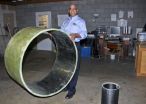Molecular 'movies' may accelerate anti-cancer drug discovery
Computer simulations shed light on the dynamic structure of a major target for therapies
2012-08-17
(Press-News.org) SALT LAKE CITY – Using advanced computer simulations, University of Utah College of Pharmacy researchers have produced moving images of a protein complex that is an important target for anti-cancer drugs. This advancement has significant implications for discovering new therapies that could attack cancer without damaging the DNA of healthy cells, according to an article published July 31, 2012 in the Proceedings of the National Academy of Sciences.
The researchers used high-performance computing technology to demonstrate that a protein complex called LSD1/CoREST undergoes major changes in shape, which are regulated by binding to a DNA-packaging protein known as histone H3. LSD1 gene expression is increased in many cancers and insight into the changes in the LSD1/CoREST complex may help to accelerate development of epigenetic drugs that reprogram cancer cells to behave more normally.
Epigenetics is the study of changes in gene expression that are not caused by alterations in the DNA itself. Instead, these changes are caused by chemical modifications that switch parts of the genome on and off to regulate gene activity. These chemical modifications occur within the epigenome, a layer of chemical labels that covers the genome, and help to determine whether specific genes are active or inactive. Epigenetic drug discovery is based on the knowledge that the epigenome is flexible and could potentially be altered by therapeutic drugs.
Lysine-specific demethylase-1 (LSD1)/CoREST is a protein complex involved in epigenetic changes. Recent studies have shown that LSD1-CoREST is a binding partner for various proteins involved in regulating genes and modifying chromatin, the combination of DNA and DNA-packaging proteins called histones that make up the nucleus of a cell. Previous research also revealed that LSD1-CoREST binds to histone H3.
"In our earlier work, we discovered that LSD1/CoREST functions as a tiny clamp that can reversibly open and close to adjust the size of its binding partners," says Riccardo Baron, Ph.D., assistant professor of medicinal chemistry at the University of Utah and lead author on the study. "The goal of this study was to learn more about the conformational changes that occur when LSD1/CoREST binds to H3."
Baron and Nadeem A. Vellore, Ph.D., postdoctoral researcher in the Baron lab, performed molecular dynamics computer simulation on existing x-ray crystal structures of LSD1/CoREST, effectively transforming a static photo of the protein complex into a molecular movie. They discovered that, in an unbound state, the arms of the LSD1/CoREST clamp exhibit remarkable rotation, shifting back and forth among open or closed configurations. They also found that binding to H3 reduces the overall flexibility of the clamp and triggers a major loss of rotation. These dynamic changes in shape help to explain the ability of LSD1/CoREST to bind to such a wide variety of partners and may also be relevant to how LSD1/CoREST performs chromatin remodeling.
Epigenetics is an active topic in cancer research because an epigenetic mechanism known as DNA or histone methylation is commonly disrupted in cancer cells. In cancer, methylation turns off critical genes, and previous research has suggested that the use of drugs to inhibit the alteration mechanism may lead to re-expression of the affected genes. Unlike traditional chemotherapy drugs, epigenetic drugs would not affect the DNA of healthy cells. This makes epigenetic drug discovery extremely promising for reducing the side effects of chemotherapy.
"Epigenetic drug discovery hinges upon identifying the right protein targets and drug molecules, which is challenging because both are highly dynamic," says Vellore. "It would be extremely difficult to hit a dynamic target using only a static photo. Increasing our understanding of the molecular dynamics of LSD1 has allowed us to screen large compound libraries effectively and to identify the molecules that are most likely to inhibit epigenetic targets."
This research is currently fueling international collaborations with leading experimentalists in enzymology and epigenetics, including the group of Andrea Mattevi at the University of Pavia in Italy.
In the past decades, computing power has steadily risen, increasing by more than one order of magnitude every six years or less. High performance computing using graphic processing units and special-purpose hardware is currently pushing scientific boundaries even further. By taking advantage of such technological advancements, the development and application of chemical theory and computational approaches are becoming increasingly relevant for addressing important biomedical problems.
"My group's long-term goal is to significantly advance the use of computer chemistry in pharmacological applications," says Baron. "I believe in the extremely fascinating idea that physics-based approaches and computers can drive the discovery of new molecules and their practical use."
INFORMATION:
Baron's work was supported by the Department of Medicinal Chemistry and the Center for High Performance Computing at the University of Utah.
END
ELSE PRESS RELEASES FROM THIS DATE:
2012-08-17
The Department of Homeland Security (DHS) Science and Technology Directorate's (S&T) new low-cost device for dismantling dangerous pipe bombs may look like a tinkerer's project, but that's no accident. The Semi Autonomous Pipe Bomb End-cap Remover (SAPBER) is unassuming in appearance, but sophisticated enough to preserve the forensic evidence needed to track down the perpetrator.
"From ten paces away, you might mistake the contraption for a pressure washer," says S&T Program Manager Christine Lee. "But step closer and you'll find an ingenious device bristling with ...
2012-08-17
The forests of the coastal regions from California to British Columbia are renowned for their unique and ancient animals and plants, such as coast redwoods, tailed frogs, mountain beavers and the legendary Bigfoot (also known as Sasquatch). Whereas Bigfoot is probably just fiction, a huge, newly discovered spider is very real. Trogloraptor (or "cave robber") is named for its cave home and spectacular, elongate claws. It is a spider so evolutionarily special that it represents not only a new genus and species, but also a new family (Trogloraptoridae). Even for the species-rich ...
2012-08-17
Insomnia sufferers in England could have greater access to successful treatment, thanks to a training programme developed as part of trials of Cognitive Behaviour Therapy for Insomnia (CBTi), funded by the Economic and Social Research Council (ESRC).
In Britain, people report having insomnia more often than any other psychological condition, including anxiety, depression and even pain, according to the Office of National Statistics. Yet the only treatment offered in most doctors' surgeries is a course of sleeping tablets.
"It is well known that sleeping pills can be ...
2012-08-17
TUCSON, Ariz. (August 17, 2012) -- Mo Ehsani, Professor Emeritus of Civil Engineering at the University of Arizona, has designed a new, lightweight underground pipe he says could transform the pipeline construction industry.
Instead of conventional concrete or steel, Ehsani's new pipe consists of a central layer of lightweight plastic honeycomb, similar to that used in the aerospace industry, sandwiched between layers of resin-saturated carbon fiber fabric.
In combination, these materials are as strong, or stronger, than conventional steel and concrete pipes, which ...
2012-08-17
When uncoupling proteins are active, mitochondria produce heat instead of ATP. This may be useful under certain circumstances, such as when an animal is hibernating. But non-hibernating animals also have them. Particularly poorly understood is the uncoupling protein UCP2. Elena Pohl and colleagues at the University of Veterinary Medicine, Vienna, show that the protein occurs mainly in cells of the immune system. The group's highly provocative findings are published in the online journal PLOS ONE.
Mitochondria represent the powerhouses of the eukaryotic cell. They ...
2012-08-17
Santa Cruz, California—Scientists have sequenced the genome of one of the iconic Galapagos finches first described by Charles Darwin. The genome of the medium ground finch (Geospiza fortis) is among the first of a planned 100 genomes of vertebrate species to be sequenced and released by an international collaboration between the Genome 10K project and BGI.
This finch genome, the first of the BGI-Genome 10K collaboration to be made available through the UCSC Genome Browser, represents both a scientific and a symbolic advancement, according to Duke University associate professor ...
2012-08-17
New research, led by University of Warwick physicist Dr Kareem Osman, has provided significant insight into how the solar wind heats up when it should not. The solar wind rushes outwards from the raging inferno that is our Sun, but from then on the wind should only get cooler as it expands beyond our solar system since there are no particle collisions to dissipate energy. However, the solar wind is surprisingly hotter than it should be, which has puzzled scientists for decades. Two new research papers led by Dr Osman may have solved that puzzle.
Turbulence pervades ...
2012-08-17
Most people are not aware of the fact that 84% of the European crops are partially or entirely dependent on insect pollination. While managed honeybees pollinate certain crops, wild bees, flies and wasps cover a very broad spectrum of plants, and thus are considered the most important pollinators in Europe.
The serious decline in the number of managed honeybees and wild bees reported in Europe over the last few decades has the potential to cause yield decreases with threats to the environment and economy of Europe. The future of the pollination services provided by bees ...
2012-08-17
A large-scale survey of the mental condition of military personnel before, during and after their posting to Afghanistan has proved thought-provoking. In total, 746 Danish soldiers took part in the survey. The soldiers completed a questionnaire five times in all – before their posting, during their time in Afghanistan and three times after their return to Denmark.
Professor Dorthe Berntsen of the Center on Autobiographical Memory Research – CON AMORE, Department of Psychology, Aarhus University, Business and Social Sciences, is responsible for the study, together with ...
2012-08-17
Researchers in India have developed a total cholesterol test that uses a digital camera to take a snapshot of the back of the patient's hand rather than a blood sample. The image obtained is cropped and compared with images in a database for known cholesterol levels.
Writing in the International Journal of Medical Engineering and Informatics, N.R. Shanker of the Sree Sastha Institute of Engineering and Technology and colleagues describe how they have developed a non-invasive way to test cholesterol levels in patients at increased risk of heart disease. Their approach ...
LAST 30 PRESS RELEASES:
[Press-News.org] Molecular 'movies' may accelerate anti-cancer drug discovery
Computer simulations shed light on the dynamic structure of a major target for therapies



